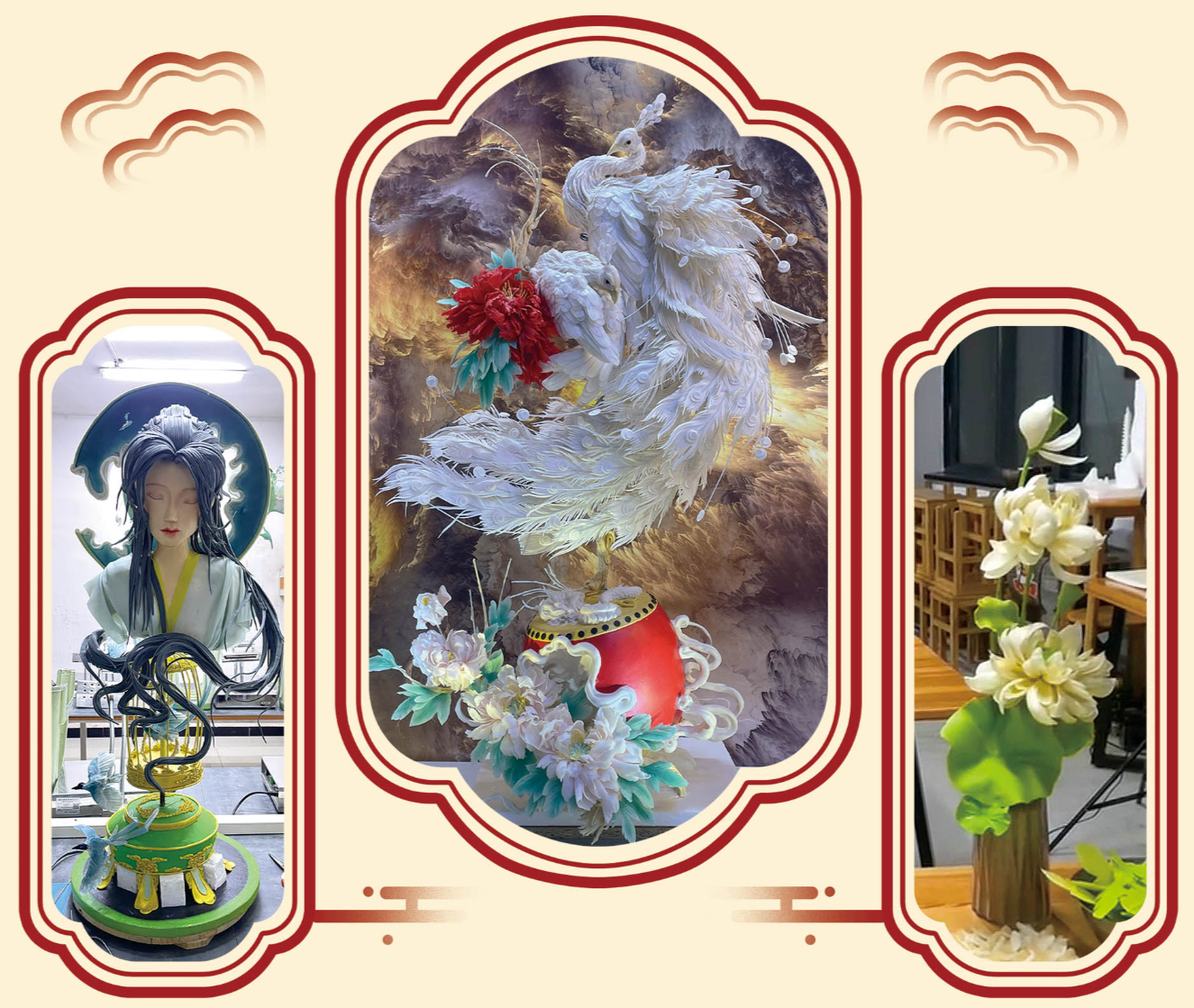Wang Yuyu, a culinary arts teacher from Ningbo, revives the ancient craft of dough modeling, showcasing exceptional skill and perseverance.

Two peacocks display their dazzling feathers above a majestic dragon, which is gracefully coiled atop a drum. The drum, placed at the base of the sculpture, is intricately adorned with carvings of peonies and clouds.
This exquisite dough modeling artwork, Huakaifugui (Blossoms Bring Prosperity), has captivated netizens across China with its ingenious design and exceptional craftsmanship. The piece was created by Wang Yuyu, a 23-year-old culinary arts teacher at Yuyao Technician College in Ningbo, Zhejiang province.
Wang began honing his sculpting skills at the age of 15, while still a student at the same college, specializing in fruit and vegetable carving.
READ MORE: Pastry chefs master the art of innovation
However, he was not content with mastering only one skill. To expand his expertise, he traveled to Hebei province in August 2024 to study dough modeling — an intangible cultural heritage craft that uses sticky rice flour as its main material. By blending the flour with pigments, artisans create vivid figures, sculpted entirely by hand or with simple tools.
According to Wang, dough modeling shares certain techniques with fruit and vegetable carving, a connection that initially inspired him to explore this ancient art form.
However, his journey into dough modeling was far from easy, as mastering the skill required extensive practice and repetition.
"I was under immense pressure during my studies in Hebei," Wang recalled. "We would wake up at 7 am and practice until late at night, with little time to rest throughout the day. The training was grueling."
Despite the stress, Wang's perseverance paid off.
"When I finished my figurines, I felt a profound sense of accomplishment and realized that all my hard work hadn't been in vain," Wang said with satisfaction.
To date, Wang has created four notable pieces, among which he is most proud of Huakaifugui, a work that took him nine days to complete.
The crafting process consists of four key steps: kneading the dough, ironing the structure, carving the dough, and painting. Each step is essential to achieving the desired final look of the figurine.
Kneading the dough, the first step, requires meticulous attention to ensure the raw material is both pliable and properly colored. This is followed by boiling the framework, which Wang considers the most arduous stage of dough modeling. "Ensuring the correct head-to-body ratio of the peacocks is a significant challenge for me. Once the iron has cooled, altering the framework becomes almost impossible," Wang explained. "I've had to try three times to get the ratio just right."
The most time-consuming part is crafting the peacock's feathers, which took Wang almost four days to complete — all 86 of them.
Each feather requires about 35 minutes to make, involving the careful rolling of dough into a mold and refining it once it has dried.
"During this process, I felt like a worker on an assembly line, repeatedly performing the precise task of sculpting each feather. But when I see how the feathers become the finest part of my work, it's all worth it," Wang said.
This is why he believes the key to mastering dough modeling lies in passion.
"Crafting can sometimes be tedious. Without a genuine love for dough modeling, I wouldn't push myself to perfect every figurine," Wang admitted. "That passion shows in the details — the pure color of the dough and the intricacy of each feather."
However, passion alone is not enough. For Wang, a true craftsman must also possess sharp observational skills and quick comprehension.
Whenever Wang begins a new piece, he carefully considers every aspect: from selecting which elements to include in the figurine to determining how these elements should be arranged, and deciding which colors would best convey the emotions he wishes to express.
ALSO READ: Tasty tradition is sweet success for culture
When working on Huakaifugui, for example, crafting the peacocks' heads alone required three attempts.
"Even though people unfamiliar with dough modeling might not notice the differences between the versions, I can't allow any imperfection in my work," he said.
For Wang, truly exceptional artwork has a soul, as craftsmen pour their hearts into their work long before the actual modeling begins — from selecting themes to sketching designs. "These steps are the foundation of a figurine," Wang said. "It's not just about the physical creation; it's about embodying the spirit of the creator."
Looking ahead, Wang plans to continue pursuing dough modeling and hopes to pass on the spirit of craftsmanship to his students and a wider audience.
"Although I spend most of my time in the workshop and sacrifice my leisure time for hobbies, I feel a deep sense of fulfillment," he said. "My goal is to offer people a glimpse into the traditional Chinese aesthetic, while also reviving this intangible cultural heritage."


